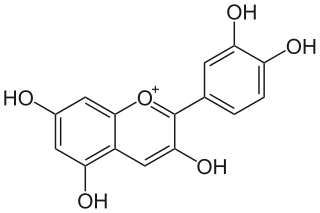Related Research Articles

Vitis vinifera, the common grape vine, is a species of flowering plant, native to the Mediterranean region, Central Europe, and southwestern Asia, from Morocco and Portugal north to southern Germany and east to northern Iran. There are currently between 5,000 and 10,000 varieties of Vitis vinifera grapes though only a few are of commercial significance for wine and table grape production.

Cyanidin is a natural organic compound. It is a particular type of anthocyanidin. It is a pigment found in many red berries including grapes, bilberry, blackberry, blueberry, cherry, chokeberry, cranberry, elderberry, hawthorn, loganberry, açai berry and raspberry. It can also be found in other fruits such as apples and plums, and in red cabbage and red onion. It has a characteristic reddish-purple color, though this can change with pH; solutions of the compound are red at pH < 3, violet at pH 7-8, and blue at pH > 11. In certain fruits, the highest concentrations of cyanidin are found in the seeds and skin. Cyanidin has been found to be a potent sirtuin 6 (SIRT6) activator.

Paeonia lactiflora is a species of herbaceous perennial flowering plant in the family Paeoniaceae, native to central and eastern Asia from eastern Tibet across northern China to eastern Siberia.

African blue basil is a hybrid basil variety, a cross between camphor basil and dark opal basil. It is one of a few types of basil that are perennial. African blue basil plants are sterile, unable to produce seeds of their own, and can only be propagated by cuttings.

Dark opal basil is a cultivar of Ocimum basilicum, developed by John Scarchuk and Joseph Lent at the University of Connecticut in the 1950s. With deep purple, sometimes mottled leaves, it is grown as much for its decorative appeal as for its culinary value. Dark opal basil was a 1962 winner of the All-American Selection award.

Ursolic acid, is a pentacyclic triterpenoid identified in the epicuticular waxes of apples as early as 1920 and widely found in the peels of fruits, as well as in herbs and spices like rosemary and thyme.

Peonidin is an O-methylated anthocyanidin derived from Cyanidin, and a primary plant pigment. Peonidin gives purplish-red hues to flowers such as the peony, from which it takes its name, and roses. It is also present in some blue flowers, such as the morning glory.
In enzymology, an anthocyanin 5-O-glucoside 6'''-O-malonyltransferase is an enzyme that catalyzes the chemical reaction

Anthocyanins, also called anthocyans, are water-soluble vacuolar pigments that, depending on their pH, may appear red, purple, blue, or black. In 1835, the German pharmacist Ludwig Clamor Marquart gave the name Anthokyan to a chemical compound that gives flowers a blue color for the first time in his treatise "Die Farben der Blüthen". Food plants rich in anthocyanins include the blueberry, raspberry, black rice, and black soybean, among many others that are red, blue, purple, or black. Some of the colors of autumn leaves are derived from anthocyanins.

The phenolic content in wine refers to the phenolic compounds—natural phenol and polyphenols—in wine, which include a large group of several hundred chemical compounds that affect the taste, color and mouthfeel of wine. These compounds include phenolic acids, stilbenoids, flavonols, dihydroflavonols, anthocyanins, flavanol monomers (catechins) and flavanol polymers (proanthocyanidins). This large group of natural phenols can be broadly separated into two categories, flavonoids and non-flavonoids. Flavonoids include the anthocyanins and tannins which contribute to the color and mouthfeel of the wine. The non-flavonoids include the stilbenoids such as resveratrol and phenolic acids such as benzoic, caffeic and cinnamic acids.

Purple corn or purple maize is group of flint maize varieties originating in South America, descended from a common ancestral variety termed "kʼculli" in Quechua. It is most commonly grown in the Andes of Peru, Bolivia and Ecuador.

Antirrhinin is an anthocyanin. It is the 3-rutinoside of cyanidin.

Chrysanthemin is an anthocyanin. It is the 3-glucoside of cyanidin.

Myrtillin is an anthocyanin. It is the 3-glucoside of delphinidin. It can be found in all green plants, most abundantly in blackcurrant, blueberry, huckleberry, bilberry leaves and in various myrtles, roselle plants, and Centella asiatica plant. It is also present in yeast and oatmeal. The sumac fruit's pericarp owes its dark red colour to anthocyanin pigments, of which chrysanthemin, myrtillin and delphinidin have yet been identified.
The pyranoanthocyanins are a type of pyranoflavonoids. They are chemical compounds formed in red wines by yeast during fermentation processes or during controlled oxygenation processes during the aging of wine. The different classes of pyranoanthocyanins are carboxypyranoanthocyanins, methylpyranoanthocyanins, pyranoanthocyanin-flavanols, pyranoanthocyanin-phenols, portisins, oxovitisins and pyranoanthocyanin dimers; their general structure includes an additional ring that may have different substituents linked directly at C-10.

Syringetin is an O-methylated flavonol, a type of flavonoid. It is found in red grape, in Lysimachia congestiflora and in Vaccinium uliginosum. It is one of the phenolic compounds present in wine.

Blue corn is several closely related varieties of flint corn grown in Mexico, the Southwestern United States, and the Southeastern United States. It is one of the main types of corn used for the traditional Southern and Central Mexican food known as tlacoyo.

Pteris ensiformis, the slender brake, silver lace fern, sword brake fern, or slender brake fern, is a plant species of the genus Pteris in the family Pteridaceae. It is found in Asia and the Pacific.
Cyanidin-3-O-glucoside 2-O-glucuronosyltransferase is an enzyme with systematic name UDP-D-glucuronate:cyanidin-3-O-beta-D-glucoside 2-O-beta-D-glucuronosyltransferase. This enzyme catalyses the following chemical reaction

Ideain, the cyanidin 3-O-galactoside, is an anthocyanin, a type of plant pigment.
References
- ↑ "Purple Sweet Potato | DDW The Colour House". DDW The Colour House. Retrieved 2017-03-20.
- ↑ Services, Eazyweb Internet. "Purple Sweet Potato Color". www.foodcolor.com. Retrieved 2017-03-20.
- ↑ "Purple Sweet Potato A Contender To Replace Artificial Food Dyes". NPR.org. Retrieved 2017-03-10.
- ↑ "Purple sweet potatoes among 'new naturals' for food and beverage colors - American Chemical Society". American Chemical Society. Retrieved 2017-03-10.
- ↑ Masaru, Yoshinaga (1995). "New Cultivar "Ayamurasaki" for Colorant Production" (PDF). Naro.
{{cite web}}: CS1 maint: url-status (link) - 1 2 3 4 Wu, Dong-mei; Lu, Jun; Zheng, Yuan-lin; Zhou, Zhong; Shan, Qun; Ma, Dai-fu (2008-07-01). "Purple sweet potato color repairs d-galactose-induced spatial learning and memory impairment by regulating the expression of synaptic proteins". Neurobiology of Learning and Memory. 90 (1): 19–27. doi:10.1016/j.nlm.2008.01.010. ISSN 1095-9564. PMID 18316211. S2CID 30267338.
- ↑ Yoshimoto, M.; Okuno, S.; Yoshinaga, M.; Yamakawa, O.; Yamaguchi, M.; Yamada, J. (1999-03-01). "Antimutagenicity of sweetpotato (Ipomoea batatas) roots". Bioscience, Biotechnology, and Biochemistry. 63 (3): 537–541. doi:10.1271/bbb.63.537. ISSN 0916-8451. PMID 10227139.
- 1 2 3 Shan, Qun; Lu, Jun; Zheng, Yuanlin; Li, Jing; Zhou, Zhong; Hu, Bin; Zhang, Zifeng; Fan, Shaohua; Mao, Zhen (2009-01-01). "Purple sweet potato color ameliorates cognition deficits and attenuates oxidative damage and inflammation in aging mouse brain induced by d-galactose". Journal of Biomedicine & Biotechnology. 2009: 564737. doi: 10.1155/2009/564737 . ISSN 1110-7251. PMC 2766785 . PMID 19865488.
- 1 2 3 Zhang, Zi-Feng; Fan, Shao-Hua; Zheng, Yuan-Lin; Lu, Jun; Wu, Dong-Mei; Shan, Qun; Hu, Bin (2009-02-01). "Purple sweet potato color attenuates oxidative stress and inflammatory response induced by d-galactose in mouse liver". Food and Chemical Toxicology. 47 (2): 496–501. doi:10.1016/j.fct.2008.12.005. ISSN 1873-6351. PMID 19114082.
- 1 2 Lu, Jun; Wu, Dong-mei; Zheng, Yuan-lin; Hu, Bin; Zhang, Zi-feng (2010-05-01). "Purple sweet potato color alleviates D-galactose-induced brain aging in old mice by promoting survival of neurons via PI3K pathway and inhibiting cytochrome C-mediated apoptosis". Brain Pathology (Zurich, Switzerland). 20 (3): 598–612. doi:10.1111/j.1750-3639.2009.00339.x. ISSN 1750-3639. PMC 8094803 . PMID 19863544.
- ↑ Timson, David J. (2014-06-01). "Purple sweet potato colour--a potential therapy for galactosemia?". International Journal of Food Sciences and Nutrition. 65 (4): 391–393. doi:10.3109/09637486.2013.860586. ISSN 1465-3478. PMID 24279733. S2CID 20751681.
- 1 2 3 4 5 6 7 8 9 Truong, Van-Den; Deighton, Nigel; Thompson, Roger T.; McFeeters, Roger F.; Dean, Lisa O.; Pecota, Kenneth V.; Yencho, G. Craig (2010-01-13). "Characterization of Anthocyanins and Anthocyanidins in Purple-Fleshed Sweetpotatoes by HPLC-DAD/ESI-MS/MS". Journal of Agricultural and Food Chemistry. 58 (1): 404–410. doi:10.1021/jf902799a. ISSN 0021-8561. PMID 20017481.
- 1 2 3 4 5 Qiu, Fan; Luo, Jianguang; Yao, Shun; Ma, Li; Kong, Lingyi (2009-06-01). "Preparative isolation and purification of anthocyanins from purple sweet potato by high-speed counter-current chromatography". Journal of Separation Science. 32 (12): 2146–2151. doi:10.1002/jssc.200900038. ISSN 1615-9314. PMID 19479751.